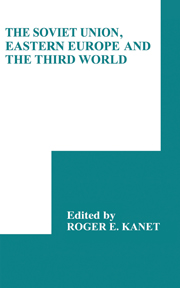Book contents
- Frontmatter
- Contents
- List of figures
- List of tables
- List of contributors
- Foreword by R.C. Elwood
- Preface by Roger E. Kanet
- PART 1 THE THIRD WORLD IN SOVIET FOREIGN POLICY
- PART 2 CMEA ECONOMIC INVOLVEMENT IN THE THIRD WORLD
- PART 3 THE SOVIET UNION IN THE MIDDLE EAST AND SOUTH ASIA
- 9 Soviet policy toward Syria in the Andropov era
- 10 Indo-Soviet security relations
- Index
- Publications from the Third World Congress for Soviet and East European Studies, Washington, 1985
9 - Soviet policy toward Syria in the Andropov era
from PART 3 - THE SOVIET UNION IN THE MIDDLE EAST AND SOUTH ASIA
Published online by Cambridge University Press: 06 July 2010
- Frontmatter
- Contents
- List of figures
- List of tables
- List of contributors
- Foreword by R.C. Elwood
- Preface by Roger E. Kanet
- PART 1 THE THIRD WORLD IN SOVIET FOREIGN POLICY
- PART 2 CMEA ECONOMIC INVOLVEMENT IN THE THIRD WORLD
- PART 3 THE SOVIET UNION IN THE MIDDLE EAST AND SOUTH ASIA
- 9 Soviet policy toward Syria in the Andropov era
- 10 Indo-Soviet security relations
- Index
- Publications from the Third World Congress for Soviet and East European Studies, Washington, 1985
Summary
The relationship between the Soviet Union and Syria in the Andropov era (November 1982–February 1984) provides a fascinating case study of the limits of a superpower's influence on a client state, particularly when that client becomes the only lever of influence a superpower has in a region deemed of great importance by the superpower's leadership. In order to analyze the Soviet–Syrian relationship, however, it is first necessary to deal with the goals of both the Soviet Union and Syria, and to determine to what degree the assistance each can offer the other is critical to the accomplishment of each country's goals.
As far as the question of Soviet goals in the Middle East is concerned, there are two major schools of thought. While both agree that the Soviet Union wants to be considered as a major factor in Middle Eastern affairs, if only because of the USSR's propinquity to the region, they differ on the ultimate Soviet goal in the Middle East. One school of thought sees Soviet Middle Eastern policy as primarily defensive in nature; that is, directed toward preventing the region from being used as a base for military attack or political subversion against the USSR. The other school of thought sees Soviet policy as primarily offensive in nature, aimed at the limitation and ultimate exclusion of Western influence from the region and its replacement by Soviet influence.
- Type
- Chapter
- Information
- The Soviet Union, Eastern Europe and the Third World , pp. 183 - 210Publisher: Cambridge University PressPrint publication year: 1988



